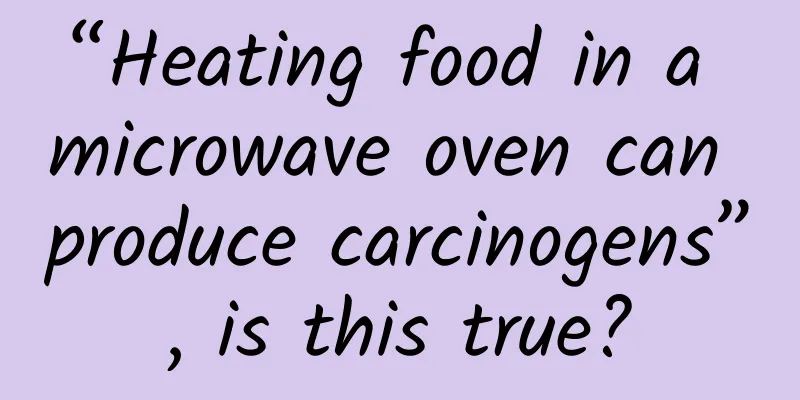“Heating food in a microwave oven can produce carcinogens”, is this true?

|
As a small household appliance that almost every family owns, microwave ovens are easy to use and bring great convenience to life. However, there are rumors online that food heated in a microwave oven can harm the body, and some even say that it can produce carcinogens. Is this true? The principle of microwave heating food is very simple. Polar molecules (such as water molecules) and ions in food rotate or move back and forth rapidly under the action of microwave alternating electric field, causing frictional heat generation at the molecular level and rapid overall temperature rise at the macro level. From the perspective of quantum mechanics, the energy of a single microwave photon is far lower than that of visible light, which is not enough to open chemical bonds and affect the internal molecular structure of food, and will not produce radiation residue. The principle of using microwaves to sterilize food is to use the thermal and non-thermal effects of microwaves to inactivate microorganisms. Microwave sterilization is different from conventional methods. Conventional methods require a sterilization temperature of 115℃-120℃ and a processing time of about 40-60 minutes, while microwave sterilization at the same temperature only takes 3-5 minutes, or even shorter. When using microwaves to sterilize food, as long as the equipment and process meet the requirements, there will be no microbial safety issues. Existing studies have shown that the nutritional quality of microwave sterilized products is better than that of traditional sterilization. Based on its heating and sterilization properties, microwaves have become a new type of food processing technology. Microwave heating is a dielectric heating method that breaks through the bottleneck of slow traditional heating methods, improves the heat conduction speed, and directly heats the entire material, which can greatly reduce the time of heat treatment, reduce food nutritional loss, and thus improve food quality. In terms of sterilization of packaged food, microwave sterilization technology can preserve the flavor, texture and nutrition of food to a greater extent compared with traditional thermal sterilization technology, and has the advantages of fast speed, low energy consumption, and no pollution. It is a new and effective green and environmentally friendly food processing technology. There are many kinds of traditional Chinese food, but due to the limitations of preservation and sterilization, many traditional foods are basically not available outside the place of production. In addition, traditional food is famous for its color, fragrance and taste, but the preservation of flavor and texture and the extension of shelf life are the main difficulties in the quantitative production of traditional Chinese food. The sterilization technology based on microwave rapid heating can completely achieve high-temperature and short-time sterilization of traditional food, greatly extending the shelf life while ensuring the characteristic quality of traditional Chinese food. In recent years, microwave technology has not fully played its due role in the food industry: mainly because the design of microwave equipment is based on electromagnetic wave transmission theory and mechanical design principles; the professional knowledge of practitioners in microwave food processing needs to be improved; and the food industry's awareness of the advantages of microwave technology is not high. To achieve the healthy development of microwave technology in the field of food processing, the first thing is to technically ensure the stability of microwave heating, and the sterilization process must also achieve food-grade sterilization effects. This requires the research and development of different products on the basis of ensuring the safety of food microorganisms, and then analyzing and evaluating the nutritional quality and safety of different microwave sterilization products, and ultimately realizing industrial production. The application of household microwave heating has become mature and widely used, but from the perspective of technological development, there is still a wide range of research and application prospects for microwave sterilization technology used in packaged food processing. It can be imagined that the ultimate goal of combining microwaves with the food processing industry must be to commercialize microwave sterilization technology in the field of high-quality food processing as soon as possible, to provide high-quality special food for various fields, and to realize the industrialization of traditional cuisines in various parts of my country, to meet the needs of passengers on high-speed trains and airplanes, and then gradually replace the takeaway food produced by small workshops with safe and nutritious microwave food, and provide safer, more nutritious and convenient food for modern fast-paced life. Source: Popular Science Times Author: Luan Donglei, Associate Professor, Department of Food Science and Engineering, School of Food Science, Shanghai Ocean University Editor: Mao Mengnan Review: Wang Fei Final judge: Chen Lei |
<<: Why can't most mirages be traced back to their original scenes? Don't they exist in real life?
Recommend
The best marketing channel selection strategy for advertising!
"If I give you 10 million, how would you spe...
Alibaba Digital Entertainment Application Center has not given up on TV business. The distribution volume in half a year has reached 197 million.
In the past three years, Alibaba Digital Entertai...
Haoxue Weike self-media VIP Baidu network disk sharing teaching courses
The micro-course education course, worth RMB 3,58...
35 Douyin operation tools to attract fans and monetize!
Tik Tok is so popular that Tencent has launched 1...
Who says eggshells can only be thrown into the trash? Scientists have discovered a new way to extract rare earth elements from eggshells!
Eggs are an indispensable nutritious food in our ...
How can educational institutions prepare good plans for Double 12 activities?
Double Eleven has just passed and Double Twelve i...
This is more damaging to the battery and more dangerous than charging it overnight!
Audit expert: Wang Jinlu Shenzhen Lingkang Techno...
British Rail Operation Group: Introducing self-driving trains
A railway development report released by the Brit...
What to do if your computer becomes slow after long-term use? Experienced drivers will teach you a few tricks
In modern society, computers are closely related ...
New media operation topic selection method!
When it comes to new media, some people say that ...
What is the investment price of Benxi used car mini program? Benxi second-hand car mini program investment price inquiry
How much does it cost to attract investment throu...
How much does it cost to develop a Panjin toy mini program? What is the quotation for Panjin Toy Mini Program development?
More and more businesses are paying attention to ...
What are the tips for building a Baidu bidding promotion plan?
A campaign plan is a large unit for managing keyw...
How much does it cost to be an agent of Kashgar Homestay Mini Program? What is the quote for Kashgar B&B mini program agent?
How much does it cost to be an agent for the Kash...
2022 Xiaohongshu user portrait insights and grass-planting analysis
The first part [User Mind Insights] mainly discus...









